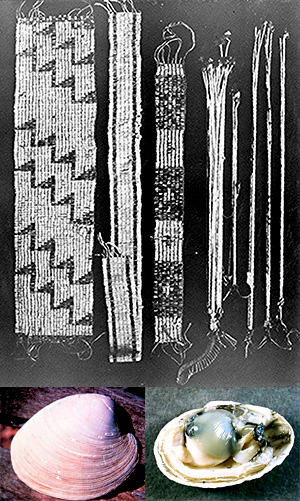Wampum: American-Made Money
|
"Making Cents"
The Signal
Saturday, May 13, 2006
| T |
A string of these small white (or black and white) beads could be valued for a beaver skin, a quiver of arrows, a bow, an ax or a pair of moccasins. These hand-made beads were fabricated from very specific clam shells known as quahogs — large saltwater clams commonly found along the Atlantic Coast. It took an Indian craftsman about six to seven days to cut, polish and drill a string of wampum beads from clam shells.
Unknown to most students of U.S. history, the majority of wampum beads were actually made by Americans in their own mills, using water-driven drills and grinders.
In the late 1700s, the Campbell family of five brothers in New Jersey who lived near the Pascack Brook, which flowed into the Hackensack River, built a mill specifically for the manufacture of wampum beads. The large quahog clams were readily available from clammers who bought, sold or ate the meat and sold the shells to the Campbells for a few cents per ton.
In their mill — one of a few specifically built to make wampum — they turned out wampum strands in days, which took Indians weeks or months of make.
When the Astor family went into high fur fashion, they ordered millions of these beads and strands from the Campbells and made both families rich.
Most of the wampum strands went into the fur trade in the Northwest and brought fur pelts to the market for clothing fashions. As long as the final beads were of the type, size and color of Indian-made beads, the Indians readily accepted Campbell-made wampum as "good money."
After the Civil War, the demand for wampum declined as more hard money made its way into wider circulation. The supply of quahog clams was so heavily harvested that mature clams rarely could be found. By 1880, the Campbell mill — the last of its kind — closed down and remained for decades a relic of olden times with lots of shells scattered about the property. The brook dried out.
Today, wampum beads assembled as necklaces, belts and long strands are valued highly as collector items, regardless of whether they were made by Indians or by the Campbell family.
Dr. Sol Taylor of Sherman Oaks is president of the Society of Lincoln Cent Collectors and author of The Standard Guide to the Lincoln Cent. Click here for ordering information.
©2006, THE SIGNAL · ALL RIGHTS RESERVED.
